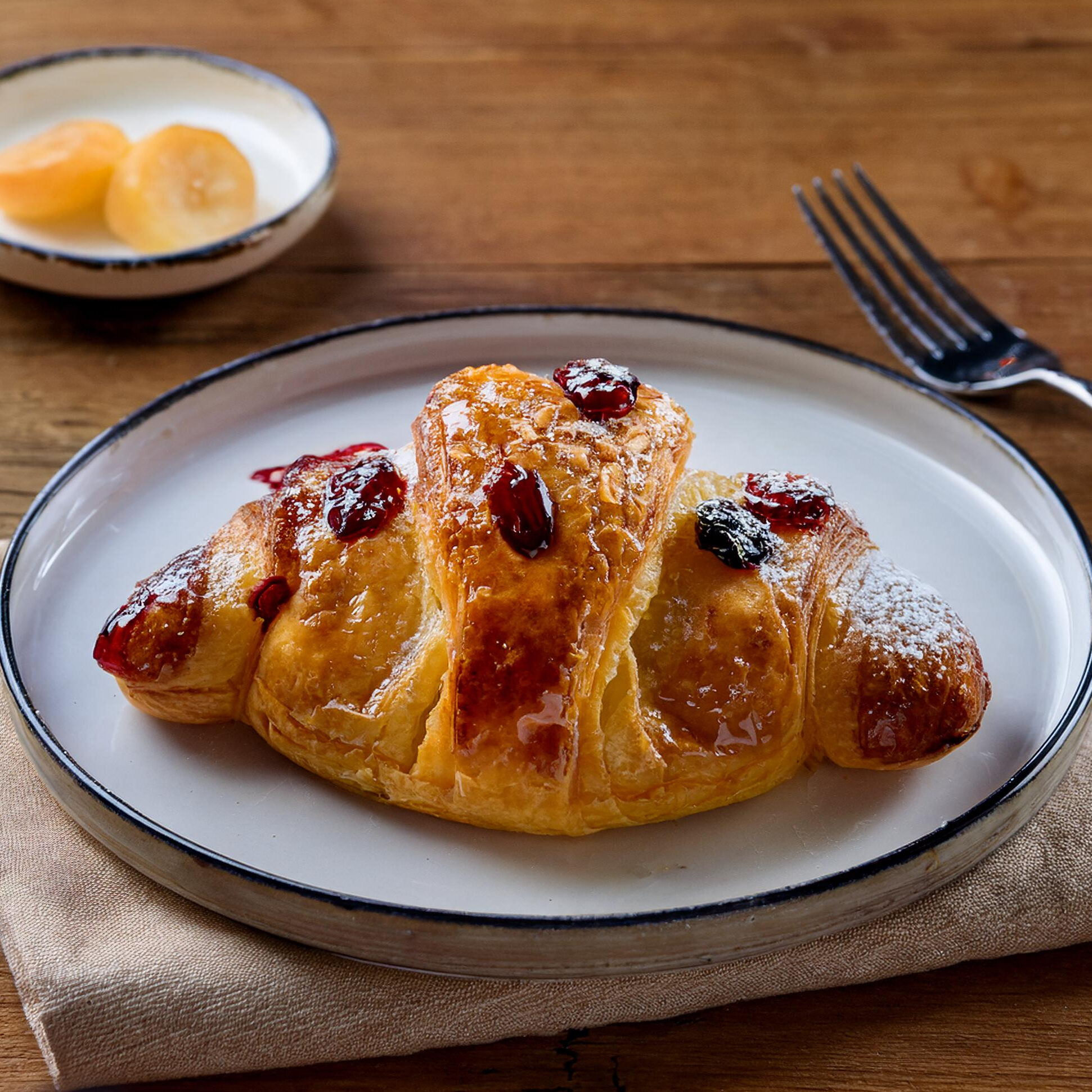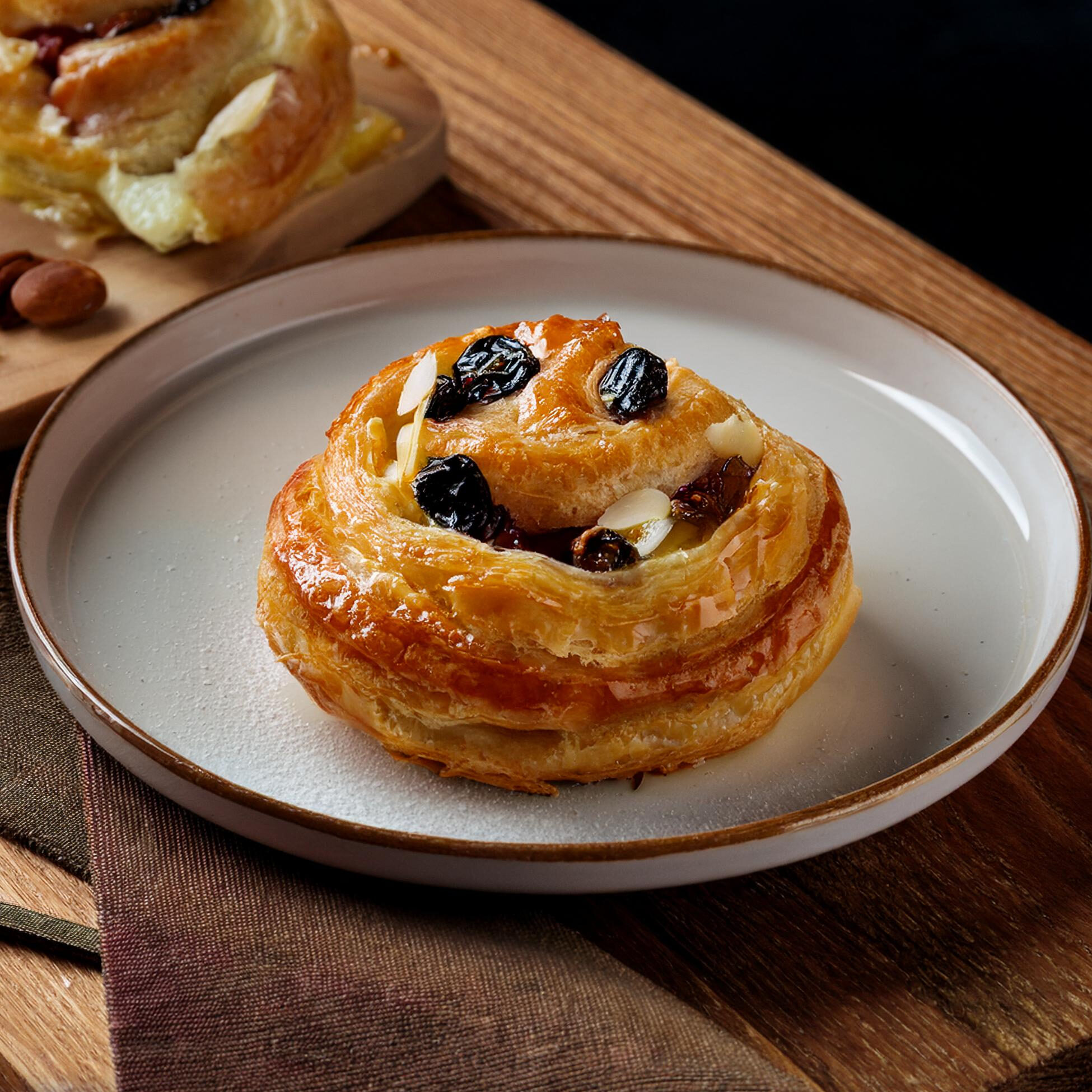Gipfeli recipe, a beloved Swiss pastry, is a delightful treat known for its buttery, flaky layers and crescent-shaped appearance. Often compared to the French croissant, Gipfeli has a unique identity, featuring a slightly denser texture and a variety of sweet or savory fillings. Whether enjoyed for breakfast, as a snack, or paired with a warm beverage, Gipfeli offers a taste of Switzerland’s rich culinary tradition.
In this article, you’ll learn everything about Gipfeli—from its origins and differences from croissants to a detailed step-by-step recipe. Perfect for home bakers and pastry enthusiasts alike, this guide will help you master the art of making Gipfeli, ensuring each bite is as authentic as if it were baked in the heart of Switzerland.

What is Gipfeli?
Gipfeli is a crescent-shaped pastry that originates from Switzerland and is a staple in Swiss bakeries and homes. Known for its buttery flavor and golden, flaky crust, Gipfeli is often enjoyed with coffee or tea as part of a traditional Swiss breakfast or snack.
Unlike its French counterpart, the croissant, Gipfeli is slightly denser and less flaky, making it a heartier option. This pastry can be enjoyed plain or filled with a variety of ingredients, ranging from sweet options like chocolate or jam to savory fillings like cheese or ham.
The Origin and History of Gipfeli
The history of Gipfeli can be traced back to the influence of Austrian and French pastries, particularly the Austrian Kipferl and the French croissant. In Switzerland, Gipfeli evolved to suit local tastes, emphasizing a denser texture and simpler preparation methods. Today, it’s a symbol of Swiss culinary heritage and is often served in homes, cafes, and hotels across the country.
How Gipfeli Differs from Croissants
While Gipfeli and croissants may look similar, their differences lie in the dough and flavor profile:
- Texture: Gipfeli is denser, whereas croissants are ultra-light and flaky due to their extensive lamination process.
- Ingredients: Gipfeli dough often includes milk or eggs, giving it a richer flavor and softer texture.
- Preparation: Gipfeli requires fewer layers of butter and a simpler lamination process compared to croissants.
These distinctions make Gipfeli a unique pastry that stands out on its own while offering the comforting familiarity of a crescent-shaped treat.
Ingredients for Making Gipfeli
Making Gipfeli requires simple, high-quality ingredients that come together to create a buttery and satisfying pastry. While the recipe is straightforward, the choice of ingredients plays a significant role in achieving the perfect texture and flavor.

Key Ingredients and Their Role
- All-Purpose Flour:
- Forms the structure of the dough, ensuring the pastry holds its shape.
- Use a high-quality flour for optimal results.
- Unsalted Butter:
- The cornerstone of Gipfeli’s buttery flavor.
- Ensures flakiness in the pastry when laminated into the dough.
- Milk:
- Adds richness to the dough and enhances its soft texture.
- Creates a slightly sweeter and more tender pastry.
- Sugar:
- Provides a touch of sweetness to the dough.
- Balances the savory notes of the butter.
- Salt:
- Enhances the overall flavor, preventing the pastry from tasting bland.
- Yeast:
- Used to leaven the dough, creating a light and airy texture.
- Active dry yeast or instant yeast both work well.
- Egg:
- Helps bind the ingredients and enriches the dough.
- Also used for an egg wash to achieve a golden, glossy finish.
Substitutions for Common Ingredients
- Butter Substitutes:
- For a dairy-free option, use vegan butter or margarine.
- Milk Alternatives:
- Replace cow’s milk with almond milk, oat milk, or soy milk for a non-dairy version.
- Sugar Alternatives:
- Use honey, maple syrup, or a sugar substitute to adjust sweetness levels.
These ingredients, combined with careful preparation, ensure that each Gipfeli is buttery, flavorful, and perfectly golden.
Tools and Equipment Needed for Gipfeli
Creating perfect Gipfeli requires the right tools and equipment to ensure precision and efficiency. While the recipe itself is straightforward, having these items on hand will make the process smoother and more enjoyable.
Essential Tools
- Mixing Bowls:
- Used for combining and kneading the dough.
- Choose a large bowl to allow room for the dough to rise.
- Rolling Pin:
- Essential for rolling out the dough into thin layers for lamination.
- A heavy, non-stick rolling pin works best for even thickness.
- Pastry Brush:
- Used to apply the egg wash for a golden and glossy finish.
- Helps evenly distribute butter during lamination.
- Baking Sheet:
- A flat, non-stick baking sheet ensures even baking.
- Use parchment paper or a silicone baking mat to prevent sticking.
- Sharp Knife or Pastry Cutter:
- Used for cutting the dough into triangular shapes for shaping the Gipfeli.
- A pizza cutter can also work for precise cuts.
- Kitchen Scale:
- Ensures accurate measurement of ingredients for consistent results.
- Clean Towel or Plastic Wrap:
- Used to cover the dough during resting and proofing to prevent it from drying out.
Optional Tools
- Dough Scraper:
- Handy for dividing and handling the dough during lamination.
- Pastry Board or Non-Stick Surface:
- Provides a smooth surface for rolling and shaping the dough.
- Cooling Rack:
- Allows freshly baked Gipfeli to cool evenly without becoming soggy.
Having the right tools will make the Gipfeli-making process easier and help you achieve professional-quality results at home.
Step-by-Step Gipfeli Recipe
Making Gipfeli from scratch may seem intimidating, but with this step-by-step guide, you’ll create buttery, flaky pastries worthy of a Swiss bakery. Follow these instructions carefully to achieve the perfect texture and flavor.
Step 1: Preparing the Dough
Ingredients:
- 3 ½ cups all-purpose flour
- ¼ cup sugar
- 1 teaspoon salt
- 2 teaspoons active dry yeast
- 1 cup warm milk (110°F or 45°C)
- 1 large egg
- 4 tablespoons unsalted butter, melted
Instructions:
- Activate the Yeast:
- In a small bowl, mix warm milk with the sugar and yeast. Let it sit for 5–10 minutes until foamy. This indicates the yeast is active.
- Combine Dry Ingredients:
- In a large mixing bowl, whisk together the flour and salt.
- Mix Wet Ingredients:
- Add the activated yeast mixture, melted butter, and egg to the dry ingredients. Mix until a sticky dough forms.
- Knead the Dough:
- Transfer the dough to a floured surface and knead for 8–10 minutes until smooth and elastic.
- Let it Rise:
- Place the dough in a lightly greased bowl, cover it with a clean towel or plastic wrap, and let it rise in a warm place for 1–2 hours or until doubled in size.
Step 2: Folding and Laminating the Butter
Ingredients:
- 1 cup cold unsalted butter
Instructions:
- Prepare the Butter Block:
- Place the butter between two sheets of parchment paper. Pound and roll it into a flat rectangle, about 8×6 inches. Chill it in the refrigerator while the dough rises.
- Roll Out the Dough:
- Once the dough has risen, punch it down and roll it into a rectangle, about 12×16 inches.
- Encase the Butter:
- Place the butter block in the center of the dough. Fold the edges of the dough over the butter, fully encasing it like an envelope.
- First Roll and Fold:
- Roll out the dough into a long rectangle, about 8×20 inches. Fold it into thirds, like a letter. Chill for 30 minutes.
- Repeat the Process:
- Repeat the rolling and folding process two more times, chilling the dough for 30 minutes between each fold.
Step 3: Shaping and Baking Gipfeli
Ingredients:
- 1 egg (for egg wash)
- Optional: fillings like chocolate, jam, or cheese
Instructions:
- Roll Out the Dough:
- After the final chill, roll the dough into a large rectangle, about ¼ inch thick.
- Cut into Triangles:
- Use a sharp knife or pastry cutter to divide the dough into long triangular shapes.
- Add Fillings (Optional):
- Place a small amount of filling near the base of each triangle.
- Shape the Gipfeli:
- Starting from the base, roll each triangle tightly toward the tip to form a crescent shape.
- Prepare for Baking:
- Place the Gipfeli on a baking sheet lined with parchment paper. Cover with a towel and let them proof for 30–45 minutes.
- Apply Egg Wash:
- Whisk the egg and brush it over each Gipfeli for a golden finish.
- Bake:
- Preheat the oven to 375°F (190°C). Bake the Gipfeli for 15–20 minutes or until golden brown.
- Cool:
- Transfer the Gipfeli to a cooling rack and let them cool slightly before serving.
Tips for Perfect Gipfeli Every Time
Creating the perfect Gipfeli requires attention to detail and a few insider tips to ensure success. Follow these guidelines to master the art of this beloved Swiss pastry.
How to Achieve the Right Flakiness
- Keep the Butter Cold:
- Cold butter is essential for creating distinct flaky layers. Work quickly when laminating, and chill the dough if it starts to soften.
- Roll Evenly:
- Ensure the dough is rolled out evenly to maintain consistent layers. Uneven rolling can lead to uneven baking.
- Chill Between Folds:
- Rest the dough in the refrigerator between folds to prevent the butter from melting and blending with the dough.
- Don’t Overwork the Dough:
- Over-kneading or over-rolling can toughen the pastry and reduce flakiness.
Common Mistakes to Avoid
- Melting Butter:
- Avoid handling the dough too much, as the heat from your hands can melt the butter and compromise the layers.
- Skipping Proofing:
- Allow the shaped Gipfeli to proof adequately before baking to ensure they rise well in the oven.
- Overloading Fillings:
- Use fillings sparingly to prevent them from leaking during baking and making the pastry soggy.
- Inconsistent Baking Temperature:
- Ensure your oven is preheated to the correct temperature. Uneven heat can cause Gipfeli to bake unevenly.
Extra Tips for Success
- Use Quality Ingredients:
- High-quality butter and flour make a noticeable difference in flavor and texture.
- Experiment with Fillings:
- Try sweet fillings like Nutella, fruit preserves, or marzipan, or savory options like smoked salmon and cream cheese.
- Store Properly:
- To maintain freshness, store Gipfeli in an airtight container at room temperature for up to 2 days or freeze for longer storage.
These tips will help you perfect your Gipfeli-making skills and impress friends and family with your baking expertise.
Variations of Gipfeli
While the classic Gipfeli is delicious on its own, the versatility of this pastry allows for countless variations. Whether you have a sweet tooth or prefer savory delights, there’s a Gipfeli for every occasion.
Sweet Gipfeli
- Chocolate-Filled Gipfeli:
- Add a square of dark chocolate near the base of the dough triangle before rolling it into shape.
- Perfect for dessert or a sweet breakfast treat.
- Cinnamon Sugar Gipfeli:
- Brush the dough with melted butter and sprinkle generously with cinnamon sugar before shaping.
- Creates a warm, aromatic pastry with a caramelized exterior.
- Jam-Filled Gipfeli:
- Use fruit preserves like raspberry, apricot, or strawberry as a filling.
- Pair with a dusting of powdered sugar for a classic look.
Savory Gipfeli
- Cheese and Herb Gipfeli:
- Sprinkle grated Gruyère or Parmesan cheese and fresh herbs (like thyme or rosemary) onto the dough before rolling.
- Ideal as a side dish or a snack with soup.
- Ham and Cheese Gipfeli:
- Layer thin slices of ham and cheese at the base of the triangle before shaping.
- A satisfying option for brunch or a quick lunch.
- Spinach and Feta Gipfeli:
- Add a spoonful of sautéed spinach and crumbled feta to the dough.
- Offers a Mediterranean twist on this Swiss classic.
These variations allow you to adapt Gipfeli to any meal or flavor preference, making them a versatile addition to your baking repertoire.
How to Serve Gipfeli
Gipfeli is a versatile pastry that can be served in various ways to suit any occasion. Whether you enjoy it plain or paired with accompaniments, this Swiss delicacy is a delight to savor.
Serving Suggestions
- For Breakfast:
- Serve warm Gipfeli with butter, fruit preserves, or honey for a simple and satisfying start to the day.
- Pair with a hot cup of coffee, tea, or hot chocolate for a classic Swiss breakfast.
- As a Snack:
- Enjoy Gipfeli as a mid-morning or afternoon snack. Sweet variations pair beautifully with milk or juice, while savory options complement herbal teas or light soups.
- For Special Occasions:
- Present an assortment of sweet and savory Gipfeli on a platter for brunch gatherings or celebrations.
- Dust sweet Gipfeli with powdered sugar or drizzle with icing for an elegant touch.
- As a Dessert:
- Sweet-filled Gipfeli, like chocolate or jam varieties, make a perfect light dessert. Serve them with a dollop of whipped cream or a scoop of vanilla ice cream for an indulgent treat.
- On the Go:
- Gipfeli is an excellent portable snack. Pack them in lunchboxes or carry them for a quick bite during busy days.
Storage Tips for Serving Fresh Gipfeli
- Room Temperature: Store Gipfeli in an airtight container for up to 2 days to maintain freshness.
- Reheating: Warm in an oven at 300°F (150°C) for 5–7 minutes to restore crispness.
- Freezing: Freeze baked Gipfeli in a sealed bag for up to 1 month. Thaw overnight and reheat before serving.
These serving ideas ensure your Gipfeli is always enjoyed at its best, whether it’s a casual breakfast or a festive occasion.
Frequently Asked Questions (FAQs)
1. What is the difference between Gipfeli and croissants?
The main difference lies in the texture and preparation. Gipfeli is denser and less flaky than croissants because it uses a simpler lamination process and may include ingredients like milk or eggs in the dough. Croissants, on the other hand, are ultra-light and flaky due to their extensive butter layers.
2. Can I make Gipfeli without yeast?
Yes, you can use baking powder as a leavening agent for a quick version, but the texture will be less airy and slightly denser compared to traditional yeast-based Gipfeli.
3. How long does it take to make Gipfeli from scratch?
Making Gipfeli typically takes about 4–5 hours, including resting and proofing time. The process can be spread over two days by preparing the dough in advance and refrigerating it overnight.
4. Can Gipfeli be made gluten-free?
Yes, you can make gluten-free Gipfeli using a high-quality gluten-free flour blend. However, the texture may differ slightly, and additional xanthan gum or binding agents might be necessary for elasticity.
5. What fillings work best for sweet Gipfeli?
Popular sweet fillings include chocolate, fruit preserves, cinnamon sugar, marzipan, or Nutella. These enhance the pastry’s natural buttery flavor.
6. Are savory Gipfeli suitable for freezing?
Yes, savory Gipfeli can be frozen after baking. Let them cool completely, wrap them individually in plastic wrap, and store them in an airtight container or freezer bag. Reheat in an oven before serving.
7. Can I use store-bought puff pastry to make Gipfeli?
Yes, store-bought puff pastry can be a convenient substitute for homemade dough. While it may not have the exact texture of traditional Gipfeli dough, it’s a quick and reliable alternative.
8. Why is my Gipfeli dough not rising properly?
This could be due to inactive yeast, insufficient proofing time, or a cold environment. Ensure the yeast is fresh, allow adequate rising time, and proof the dough in a warm area (about 75–80°F or 24–27°C).
Conclusion and Final Thoughts
Gipfeli is more than just a pastry—it’s a cherished part of Swiss culinary tradition that brings joy to breakfast tables, snack times, and special gatherings. With its buttery, golden crust and versatile variations, Gipfeli offers something for everyone, whether you prefer the classic plain version, sweet fillings like chocolate and jam, or savory options like cheese and ham.
By following this detailed recipe and incorporating the tips provided, you can create Gipfeli that rivals those found in the finest Swiss bakeries. Whether you’re a seasoned baker or a beginner, this guide will help you master the art of Gipfeli and add a touch of Swiss charm to your baking repertoire.
For more pastry inspiration and creative ideas, check out Champs Recipes and explore their collection of Churro Cheesecake Recipes. Happy baking!
If you’re curious about more culinary tips and recipe ideas, explore Value Recipe for more creative inspirations.
